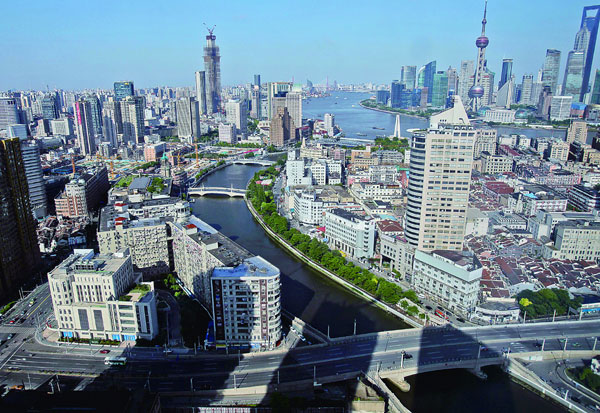Water town
Updated: 2014-11-24 10:22
(Shanghai Star)
|
|||||||||
 |
|
Suzhou creek: Shanghai is a city lucky enough to have two bodies of water run through it.[Photo by Zhu gang/for shanghai Star] |
Shanghai’s Suzhou Creek has witnessed much of the city’s history. Zhou Wenting travels this storied body of water and finds its most fascinating spots.
Some lucky cities can boast a great body of water, like London with the river Thames and Paris with the river Seine. Shanghai is privileged enough to have two great bodies of water: Huangpu River and Suzhou Creek.
Huangpu River became famous when colonists established clusters of grand buildings on its banks on what became known as the bund. Today, the bund overlooks the breathtaking skyline of Lujiazui financial district. Shanghai’s other body of water, however, Suzhou Creek, has been somewhat overshadowed.
Suzhou Creek links the inland cities of Jiangsu province with Shanghai. When the British colonists, who arrived in the city after it was opened as a commercial port in 1843 found they could reach Suzhou, Jiangsu province, via the creek, they named it Suzhou Creek.
Thanks to its location, a large amount of cargo and travelers were transported via the creek before rail links were established.
But after a century of being utilized as a waterway to transport goods and labor, the creek grew dark and smelly. Industrial factories were established along the banks. In the 1990s it became a key task of the city government to clean the creek.
Suzhou Creek, which snakes 17 km from the iconic Waibaidu Bridge downtown to the outer ring road in west Shanghai, maps the changing periods of the city’s history, including the imprints of the concessions, the beginning of industrialization and the improvement in people’s living conditions.
- India plans high-speed rail project with China
- S. Korea to test-transport Russian coal import via DPRK port
- Dozens take refuge from Japan quake aftershocks
- S. Korea holds drill in islets disputed with Japan
- Yingluck mulls over returning to politics
- French, British banks press EU to revise bank reform plans

 Sports moments of the week: Nov 17-23
Sports moments of the week: Nov 17-23
 42nd American Music Awards held in Los Angeles
42nd American Music Awards held in Los Angeles
 A retrospection of righted wrongs
A retrospection of righted wrongs
 Top 10 kinds of foreigners in China
Top 10 kinds of foreigners in China
 Anxious Ferguson waits for grand jury's decision
Anxious Ferguson waits for grand jury's decision
 Mascots from Olympic, Paralympic games arrive in Rio
Mascots from Olympic, Paralympic games arrive in Rio
 China's boxer Zou Shiming defeats unbeaten Thai
China's boxer Zou Shiming defeats unbeaten Thai
 Mountains echo to the sound of music
Mountains echo to the sound of music
Most Viewed
Editor's Picks

|

|

|

|

|

|
Today's Top News
China's interest-rate cut shows willingness to stimulate growth
LA mayor touts city's ties to China
Wall St ends at records on central bank action
US admiral sees balance in US-China relationship
New York leads way in boom in real estate
Hagel resigning as US defense secretary
80% of China's rich aspire to overseas education
US aids in return of economic fugitives
US Weekly

|

|








